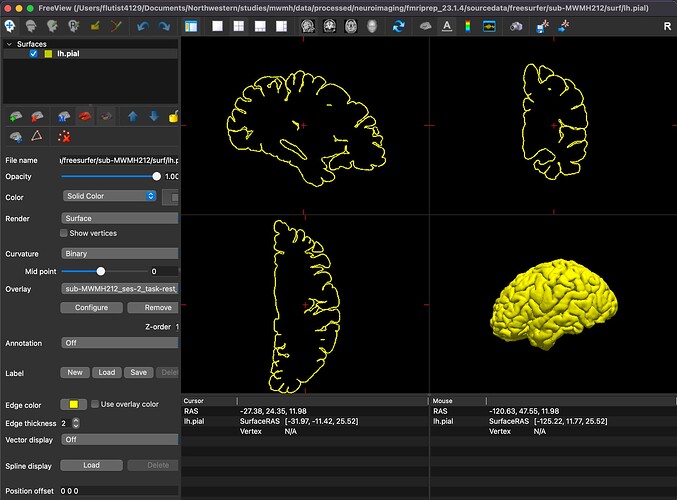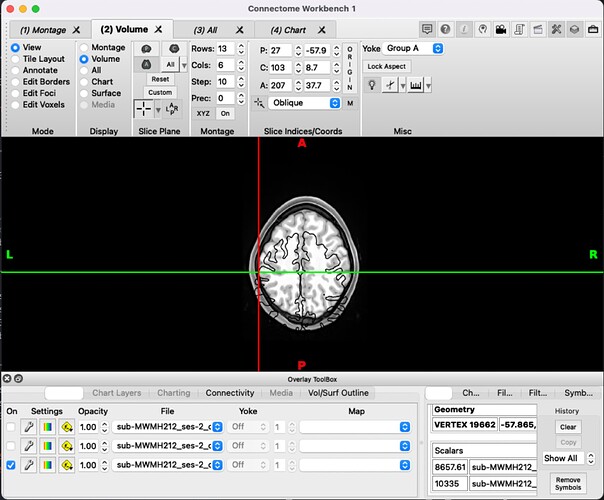Summary of what happened:
I have been working on a mini pipeline to get fmriprep outputs in the native volume space (will change to post-processed data in the same space later) onto the fsLR32k surface for use in templateICAr. The pipeline runs, but I am having trouble checking the surface quality in workbench because my final functional surface does not seem to map onto a volume space. I am wondering, must there be a volume that matches the final surface I am viewing in workbench? If so, how can I identify the appropriate volume?
Also, I believe step (4) is creating a registration gifti from subject’s native freesurfer surface space to fsLR32k space, but it is not clear to me from the documentation. Does anyone know for sure if this is the case?
Note: I came up with the steps for the pipeline using a very helpful pdf I found online (Resampling-FreeSurfer-HCP.pdf) and ChatGPT.
The pipeline:
ssfreedir="/projects/b1108/studies/mwmh/data/processed/neuroimaging/fmriprep_23.1.4/sourcedata/freesurfer/sub-"${subid}
ssprepdir="/projects/b1108/studies/mwmh/data/processed/neuroimaging/fmriprep_23.1.4/sub-"${subid}"/ses-"${sesid}
sssurfdir="/projects/b1108/studies/mwmh/data/processed/neuroimaging/surf/sub-"${subid}"/ses-"${sesid}
hcptempdir=""
export SUBJECTS_DIR="/projects/b1108/studies/mwmh/data/processed/neuroimaging/fmriprep_23.1.4/sourcedata/freesurfer"
tfdir="/projects/b1108/templateflow"
fslrdir=${tfdir}"/tpl-fsLR"
##### 1) Project the subject's BOLD data to their native freesurfer surface
mri_vol2surf --src ${ssprepdir}/func/sub-${subid}_ses-${sesid}_task-rest_space-T1w_desc-preproc_bold.nii.gz \
--out ${sssurfdir}/sub-${subid}_ses-${sesid}_task-rest_space-T1w_desc-preproc_bold_lh.mgh \
--regheader sub-${subid} --hemi lh
mri_vol2surf --src ${ssprepdir}/func/sub-${subid}_ses-${sesid}_task-rest_space-T1w_desc-preproc_bold.nii.gz \
--out ${sssurfdir}/sub-${subid}_ses-${sesid}_task-rest_space-T1w_desc-preproc_bold_rh.mgh \
--regheader sub-${subid} --hemi rh
# View the BOLD data on the subject's native freesurfer surface
freeview -f ${SUBJECTS_DIR}/sub-${subid}/surf/lh.pial:overlay=${sssurfdir}/sub-${subid}_ses-${sesid}_task-rest_space-T1w_desc-preproc_bold_lh.mgh:overlay_threshold=2,5
##### 2) Convert the freesurfer spherical surface to gifti format
mris_convert ${ssfreedir}/surf/lh.sphere ${sssurfdir}/lh.sphere.gii
mris_convert ${ssfreedir}/surf/rh.sphere ${sssurfdir}/rh.sphere.gii
##### 3) Convert the BOLD data on the subject's native freesurfer surface to gifti format
mri_convert ${sssurfdir}/sub-${subid}_ses-${sesid}_task-rest_space-T1w_desc-preproc_bold_lh.mgh \
${sssurfdir}/sub-${subid}_ses-${sesid}_task-rest_space-T1w_desc-preproc_bold_lh.func.gii
mri_convert ${sssurfdir}/sub-${subid}_ses-${sesid}_task-rest_space-T1w_desc-preproc_bold_rh.mgh \
${sssurfdir}/sub-${subid}_ses-${sesid}_task-rest_space-T1w_desc-preproc_bold_rh.func.gii
##### 4) Get registration gifti from subject's native freesurfer surface space
##### to fsLR32k space (?)
wb_shortcuts -freesurfer-resample-prep ${ssfreedir}/surf/lh.white \
${ssfreedir}/surf/lh.pial \
${ssfreedir}/surf/lh.sphere.reg \
${hcptempdir}/fs_LR-deformed_to-fsaverage.L.sphere.32k_fs_LR.surf.gii \
${sssurfdir}/lh.midthickness.surf.gii \
${sssurfdir}/sub-${subid}.L.midthickness.32k_fs_LR.surf.gii \
${sssurfdir}/lh.sphere.reg.surf.gii
wb_shortcuts -freesurfer-resample-prep ${ssfreedir}/surf/rh.white \
${ssfreedir}/surf/rh.pial \
${ssfreedir}/surf/rh.sphere.reg \
${hcptempdir}/fs_LR-deformed_to-fsaverage.R.sphere.32k_fs_LR.surf.gii \
${sssurfdir}/rh.midthickness.surf.gii \
${sssurfdir}/sub-${subid}.R.midthickness.32k_fs_LR.surf.gii \
${sssurfdir}/rh.sphere.reg.surf.gii
##### 5) Use the registration gifti from (4) to project the BOLD data on the
##### subject's native freesurfer surface to fsLR32k space
wb_command -metric-resample ${sssurfdir}/sub-${subid}_ses-${sesid}_task-rest_space-T1w_desc-preproc_bold_lh.func.gii \
${sssurfdir}/lh.sphere.reg.surf.gii \
${hcptempdir}/fs_LR-deformed_to-fsaverage.L.sphere.32k_fs_LR.surf.gii \
ADAP_BARY_AREA \
${sssurfdir}/sub-${subid}_ses-${sesid}.task-rest.L.32k_fs_LR.func.gii \
-area-surfs ${sssurfdir}/lh.midthickness.surf.gii \
${sssurfdir}/sub-${subid}.L.midthickness.32k_fs_LR.surf.gii
wb_command -metric-resample ${sssurfdir}/sub-${subid}_ses-${sesid}_task-rest_space-T1w_desc-preproc_bold_rh.func.gii \
${sssurfdir}/rh.sphere.reg.surf.gii \
${hcptempdir}/fs_LR-deformed_to-fsaverage.R.sphere.32k_fs_LR.surf.gii \
ADAP_BARY_AREA \
${sssurfdir}/sub-${subid}_ses-${sesid}.task-rest.R.32k_fs_LR.func.gii \
-area-surfs ${sssurfdir}/rh.midthickness.surf.gii \
${sssurfdir}/sub-${subid}.R.midthickness.32k_fs_LR.surf.gii
##### 6)
wb_command -set-structure ${sssurfdir}/sub-${subid}_ses-${sesid}.task-rest.L.32k_fs_LR.func.gii CORTEX_LEFT
wb_command -set-structure ${sssurfdir}/sub-${subid}_ses-${sesid}.task-rest.R.32k_fs_LR.func.gii CORTEX_RIGHT
# View the BOLD data on the fsLR32k surface
wb_view ${sssurfdir}/sub-${subid}.L.midthickness.32k_fs_LR.surf.gii \
${sssurfdir}/sub-${subid}_ses-${sesid}.task-rest.L.32k_fs_LR.func.gii \
${sssurfdir}/sub-${subid}.R.midthickness.32k_fs_LR.surf.gii \
${sssurfdir}/sub-${subid}_ses-${sesid}.task-rest.R.32k_fs_LR.func.gii \
${ssprepdir}/anat/sub-${subid}_ses-${sesid}_desc-preproc_T1w.nii.gz
wb_command -file-information ${sssurfdir}/sub-${subid}_ses-${sesid}.task-rest.L.32k_fs_LR.func.gii
# returns "Maps to Volume: false"
Version:
Freesurfer: 7.4.1
Connectome Workbench: 1.5.0
fMRIPrep: 23.1.4
Environment (Docker, Singularity, custom installation):
Local
Data formatted according to a validatable standard? Please provide the output of the validator:
BIDS
Screenshots / relevant information:
freeview -f ${SUBJECTS_DIR}/sub-${subid}/surf/lh.pial:overlay=${sssurfdir}/sub-${subid}_ses-${sesid}_task-rest_space-T1w_desc-preproc_bold_lh.mgh:overlay_threshold=2,5
returns
and
wb_view ${sssurfdir}/sub-${subid}.L.midthickness.32k_fs_LR.surf.gii \ ${sssurfdir}/sub-${subid}_ses-${sesid}.task-rest.L.32k_fs_LR.func.gii \ ${sssurfdir}/sub-${subid}.R.midthickness.32k_fs_LR.surf.gii \ ${sssurfdir}/sub-${subid}_ses-${sesid}.task-rest.R.32k_fs_LR.func.gii \ ${ssprepdir}/anat/sub-${subid}_ses-${sesid}_desc-preproc_T1w.nii.gz
returns
so clearly ${ssprepdir}/anat/sub-${subid}_ses-${sesid}_desc-preproc_T1w.nii.gz is not the corresponding volume space.



